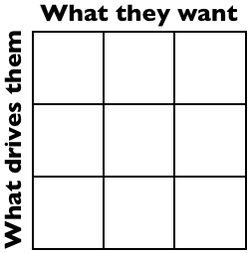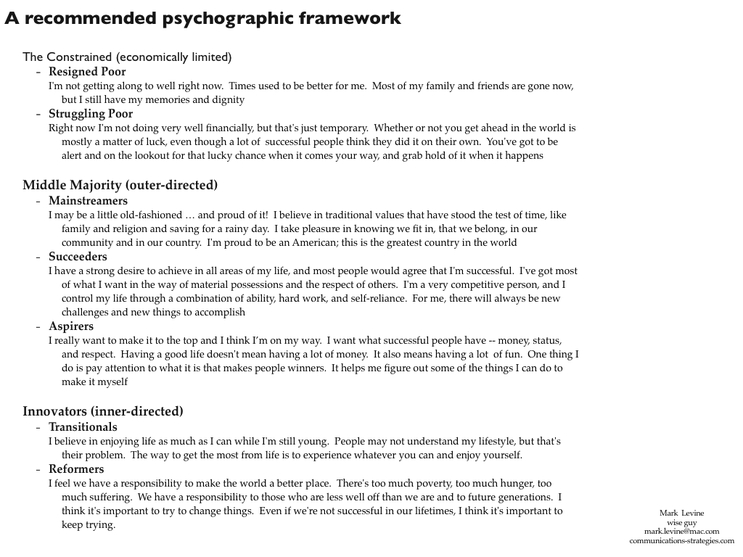Understanding your audience:
Want they want and What drives them
Want they want and What drives them
In order to create a Brand Story that will be heard, remembered and potentially acted upon, we need to understand to whom we're speaking. We know we are not telling our story to "Women, 18-49, with incomes over $50,000". Our target may well have all these characteristics but there undoubtedly are other characteristics that define that subset of these folks who are likely to be intrigued by what we have to say.
Stories have to be crafted around some concept of the target: what they are looking for, what drives their decisions, what is important to them. My approach is fairly straight-forward. I create a two dimensional table. One dimension is defined by what folks want from an offering in this category. If we're talking cars, some folks are looking for a living room on wheels, some folks are looking for the most economic way to get from point A to point B, some folks want a people and thing mover, some folks want something exciting, etc.
But even within these tranches of consumers, for example the people/thing movers for whom we have our mini-van, there are going to be folks who are driven in their decision-making by wanting something that fits in with what their neighbors have, some who want something that says that they have made it, some who want the best quality available in this category, etc.
What is differentiating these folks and what defines the second dimension of of my segmentation chart is what is usually called psychographics, the distinctive clusters of folks with distinctly different sets of goals, motivations and values. These clusters are often represented by stereotypes of the dominant groups. There are competing sets of stereotypes and none is right or wrong, just different ways of slicing and dicing.
Stereotypes may understate the complexity of those around us, but I have found the stereotypes in the chart below are very useful at distinguishing groups of folks to whom I would tell quite different stories about what I have on offer. I would likely emphasize different features and benefits to these different groups of folks. More importantly, I would tell my story in fundamentally different ways in order for them to see how my offering fits in their lives, to which of their priorities and values I am speaking, what my offering means in their lives.
By combining "What they want" and "What drives them" I can usually find a target (or targets) for whom I can build a persuasive Brand Story.
Stories have to be crafted around some concept of the target: what they are looking for, what drives their decisions, what is important to them. My approach is fairly straight-forward. I create a two dimensional table. One dimension is defined by what folks want from an offering in this category. If we're talking cars, some folks are looking for a living room on wheels, some folks are looking for the most economic way to get from point A to point B, some folks want a people and thing mover, some folks want something exciting, etc.
But even within these tranches of consumers, for example the people/thing movers for whom we have our mini-van, there are going to be folks who are driven in their decision-making by wanting something that fits in with what their neighbors have, some who want something that says that they have made it, some who want the best quality available in this category, etc.
What is differentiating these folks and what defines the second dimension of of my segmentation chart is what is usually called psychographics, the distinctive clusters of folks with distinctly different sets of goals, motivations and values. These clusters are often represented by stereotypes of the dominant groups. There are competing sets of stereotypes and none is right or wrong, just different ways of slicing and dicing.
Stereotypes may understate the complexity of those around us, but I have found the stereotypes in the chart below are very useful at distinguishing groups of folks to whom I would tell quite different stories about what I have on offer. I would likely emphasize different features and benefits to these different groups of folks. More importantly, I would tell my story in fundamentally different ways in order for them to see how my offering fits in their lives, to which of their priorities and values I am speaking, what my offering means in their lives.
By combining "What they want" and "What drives them" I can usually find a target (or targets) for whom I can build a persuasive Brand Story.


